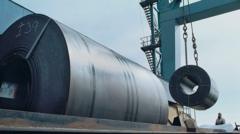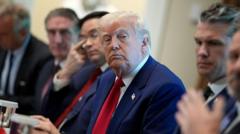In a controversial move, President Donald Trump has signed an executive order that will raise tariffs on steel and aluminium imports from 25% to 50%. This alteration, effective Wednesday, marks the second increase in tariffs since March, and aims to bolster the U.S. steel industry. However, industry analysts warn that such drastic measures could lead to dire consequences, including retaliation from international trading partners and increased costs for American manufacturers and consumers.
US Steel and Aluminium Tariffs Surge to 50%, Raising Concerns

US Steel and Aluminium Tariffs Surge to 50%, Raising Concerns
President Trump has announced a significant increase in tariffs on steel and aluminium imports, causing alarm among American businesses and trade partners.
The decision has heightened tension not only within the U.S. industry but also with foreign suppliers, prompting anxiety among businesses that rely on imported metals. For instance, Rick Huether, CEO of a Maryland-based company that fabricates products from imported steel, expressed disbelief and concern over the impact this decision would have on his operations. He highlighted that the drastic changes could potentially force customers to explore alternative materials such as plastic or paper, echoing sentiments shared by others in the sector.
While the U.S. is the world’s largest steel importer, predominantly sourcing from Canada, Brazil, Mexico, and South Korea, the latest tariffs come after previous exemptions were ended as part of a shift in trade policy under Trump. During a rally at a U.S. Steel facility, the president emphasized that the increased tariffs were meant to ensure domestic suppliers would be the only option for American corporations, claiming that a 50% tariff would effectively prevent imports from undercutting U.S. businesses.
In response to the looming tariffs, Canadian and European firms are preparing to impose counter-tariffs on U.S. goods, leading to a potential trade conflict. The European Commission has indicated ongoing negotiations to find a compromise, with hopes that the U.S. might reconsider the latest stance. Discussions are particularly pressing for the UK, which had previously secured a carve-out for its steel and aluminium exports, with Trade Secretary Jonathan Reynolds expressing resolve to sustain negotiations with the U.S. to protect these benefits.
As companies brace for higher metal prices, consequences for the broader U.S. economy remain grave, with estimates suggesting that while the tariffs may support steel jobs domestically, the overall job losses in other sectors would be significantly higher. Critics cite a historical analysis suggesting that prior tariffs created around 1,000 jobs in steel, but led to the loss of 75,000 jobs in manufacturing and construction, and warn that this latest action could exacerbate the situation. As businesses face unpredictable costs and mounting pressure, many are left wondering how long these changes will destabilize their operations and the economy at large.
Economists and industry leaders alike are calling for an evaluation of the ambiguity surrounding the long-term effects of the tariffs, with some pleading for a return to stability that could minimize adverse outcomes for American workers and businesses.
While the U.S. is the world’s largest steel importer, predominantly sourcing from Canada, Brazil, Mexico, and South Korea, the latest tariffs come after previous exemptions were ended as part of a shift in trade policy under Trump. During a rally at a U.S. Steel facility, the president emphasized that the increased tariffs were meant to ensure domestic suppliers would be the only option for American corporations, claiming that a 50% tariff would effectively prevent imports from undercutting U.S. businesses.
In response to the looming tariffs, Canadian and European firms are preparing to impose counter-tariffs on U.S. goods, leading to a potential trade conflict. The European Commission has indicated ongoing negotiations to find a compromise, with hopes that the U.S. might reconsider the latest stance. Discussions are particularly pressing for the UK, which had previously secured a carve-out for its steel and aluminium exports, with Trade Secretary Jonathan Reynolds expressing resolve to sustain negotiations with the U.S. to protect these benefits.
As companies brace for higher metal prices, consequences for the broader U.S. economy remain grave, with estimates suggesting that while the tariffs may support steel jobs domestically, the overall job losses in other sectors would be significantly higher. Critics cite a historical analysis suggesting that prior tariffs created around 1,000 jobs in steel, but led to the loss of 75,000 jobs in manufacturing and construction, and warn that this latest action could exacerbate the situation. As businesses face unpredictable costs and mounting pressure, many are left wondering how long these changes will destabilize their operations and the economy at large.
Economists and industry leaders alike are calling for an evaluation of the ambiguity surrounding the long-term effects of the tariffs, with some pleading for a return to stability that could minimize adverse outcomes for American workers and businesses.




















